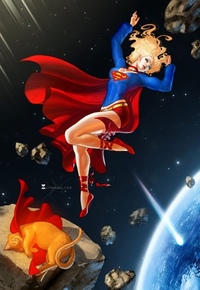- Posts: 1576
- Thank you received: 503
Credits
it List Characters as created by Jerry Segal and Joe Shuster.
Which is fine-superman does show up in the show as does Jimmy Olsen.
However...
Supergirl was created by Otto Bender and Al Pastino.
(it should be noted that Bender also created Mary Marvel, which is an inspiration here. Its clearly his idea, and Pastino cape and skirt design)
I mean Segal and shuster have done various lawsuits to get there name on superman-but i would hope they would get credit without that.
Please Log in or Create an account to join the conversation.
- castor
-
 Topic Author
Topic Author
- Offline
- Platinum Member
-

The Supergirl show, I think, gives them a based on the characters created by... credit -- which is basically tv speak for "this is a spin off of something else, created by...". The Bionic Woman show, likewise, carried a "based on the character created by Martin Caidin" credit, even though she was created by writer/producer Kenneth Johnson, and Caidin never wrote for either show (he only wrote the SM$M novels.)
Otto Binder and Al Plastino were hired hands who, like Jerry and Joe, were not entitled to a formal credit for their creation by dint of the contract they signed. It is dubious whether the incentive to create Supergirl really came from Binder anyway. Supergirl was a brand new strip, designed from the start as a regular backup feature in Action Comics (presumably to attract the young female audience who were known to tune in to the George Reeves tv show.) Most likely it was Mort Weisinger, head of 'Superman' at the time, who came up with the idea and simply commissioned Binder/Plastino to realise it.
R5
Please Log in or Create an account to join the conversation.
- five_red
-

- Offline
- Moderator
-

- Posts: 449
- Thank you received: 966
Marvel does mention characters created in the 60's (same laws even though it's a decade later)... of course part of that is Stan Lee getting his name out and he ran Marvel for awhile ... It was a big deal when Spider-Man ran with "Spider-Man, created by Stan Lee and Steve Ditko" (and not just Stan). (That being one of the more famous artists complaining due to lack of proper credit.)
Mark Waid mentioned that he got nothing for Man of Steel even though it was significantly based off one of his stories. He didn't even get invited to the premiere. OTH, he said that "marvel invites me to everything". From reading around Paul Levitz used to make sure that artists and writers were credited when adaptations were made of the characters they made, and that meant they got a bit of money. Not a lot, but some. But DC Comics was under zero legal obligation to credit them or pay them any money. So, now Levitz isn't running the show and it doesn't always happen.
Last weekend I was at a convention and spoke with Mike W. Barr. He created Katana, who is being used in the Suicide Squad movie. He said that he was being credited and getting some renumeration for it (he didn't say how much, and I wouldn't have asked that). (It came up as he has images of her from the movie that he was signing as "he created the character"). It'll be interesting to see the credits when the movie appears.
I guess i Should check the credits on Flash -- Conway's statements imply that DC won't have credited Bob Kanigher and Carmine Infantino for Barry Allen (He's derivative of Jay Garrick .. .I wonder if Jay Garrick was credited to Fox and Lampert?)
I guess I'm going to have to check...from my check on Hulu (which involved a bit of swearing as Hulu immediately shrinks and hides credits and defaults to "go to next episode", and makes it hard to scrub back through to the start of the credits .. but I didn't see anything there for Garrick let alone Barry. (Good chance I could have missed it.)
IIRC, I think Gerry Conway says he gets 25 cents when Felicity Smoak appears in an episode of Arrow or Flash.
Here's him talking about how that changed when Levitz left. The bit about Killer Frost and "no one created Caitlin Snow" is interesting. But you can see the logic here in Supergirl. Old methods would have credited Binder and Plastino. New method, she's "derivative" so no credit (using a DC Comics defined use of that term, not a copyright law use of that term). They credit the Siegel's family due to Superman and existing contracts with them. (This carries through to even the Supergirl Wikipedia page, which references Seigel and Shuster but not Binder and Plastino. The Flash TV page just says "based on Characters appearing in DC Comics")
www.newsarama.com/24341-gerry-conway-cal...-royalty-issues.html
en.wikipedia.org/wiki/Supergirl_(U.S._TV_series)
I also doubt that Plastino and Binder had contracts that said they wouldn't get credited, nor does the "hired hand" bit apply, the "work for hire" derivation was created in 1976 long after Supergirl. It's the lack of such classifications that get things into the murky waters on older characters. Thus suits over Superman, Captain America, etc. It doesn't seem like they should be able to blanket ignore Plastino and Binder -- but they are, so they must be able to. (The lawyers in this area aren't stupid. So at the very least NONE of this is even mildly accidental.) At least Plastino gets his names on buildings in the show.
OTH, in the 70's marvel was ruthless for taking full control of characters and to this day they still do some stomping. They were a bit ruthless during Ghost Rider ... but I think the finally backed on that. At one point they wanted the original creator of Ghost Rider (created BEFORE he came to marvel) to pay them back for all the money he'd made at conventions drawing Ghost Rider (The proper legal term for a company acting like that is "asshat".). Marvel had done some great (for it) legal moves to get everything a "work for hire" quickly after '76, down to having it on the paychecks. By signing your paycheck you confirmed that everything you just got paid for was a work for hire. They also had big contracts about that (this in tern, IIRC led to artist revolting and forming image in the 90's). SO they got Friedrich to essentially sign over Ghost Rider to continue to work ... which was a stupid move on his part. Though if he hadn't he'd have been out of work and Marvel just would have stopped using Ghost Rider.
NEW contracts are much better defined on rights and such.
Also, the rights issue is something that directly led to the creation of Image Comics in the 90's, which in turn led to DC and Marvel being a bit more generous in that regard (for new and old works).
Please Log in or Create an account to join the conversation.
- TwiceOnThursdays
-

- Offline
- Elite Member
-

- Posts: 1113
- Thank you received: 834
TwiceOnThursdays wrote: It's interesting that they get no mention.
Marvel does mention characters created in the 60's (same laws even though it's a decade later)... of course part of that is Stan Lee getting his name out and he ran Marvel for awhile ... It was a big deal when Spider-Man ran with "Spider-Man, created by Stan Lee and Steve Ditko" (and not just Stan). (That being one of the more famous artists complaining due to lack of proper credit.)
But they are very different companies, at least up until the mid 1970s. Marvel, under Stan Lee, took pride in crediting its artists and writers as part of the Marvel bullpen 'brand' image -- even devising nicknames for them; DC hardly ever publicly credited its creative staff. Marvel let artists keep their original artwork; DC retained the art. Marvel paid reprint fees if work was reused; DC paid a flat page rate, no matter how many times the art was reprinted. Marvel allowed each artist to develop their own style; DC promoted a house style and even modified respected artist's work to fit its brand image.
It isn't clear, however, whether Marvel's crediting its creative staff actually gained them any extra legal powers. As far as I'm aware, in the 1960s they just did it as part of their brand -- not because they had to.
It wasn't until Carmine Infantino reached a position of power that artists and writers started to get a new deal under DC. And just when things were getting good, they fired him.
I also doubt that Plastino and Binder had contracts that said they wouldn't get credited, nor does the "hired hand" bit apply, the "work for hire" derivation was created in 1976 long after Supergirl.
Binder and Plastino would have been paid on basic page rates, based on the number of script or art pages they produced each month. Their contracts didn't have to say they wouldn't get credited, because anything they created would have been property of DC anyway.
The Siegel and Shuster relationship with DC was different, at least during the first decade that their initial contract ran. They developed the Superman character and approached DC, who struck a deal to publish their character -- like an independent inventor who creates a new product, and sells the idea to a big corporation. But Binder and Plastino weren't in that same position. They were paid workers under the employ of DC to produce stories and art -- like an inventor who works for a big corporation, and whose work is owned by his employer.
The process at DC is well documented in the book Men of Tommorrow by Gerard Jones (which deals extensively with the business side of DC Comics from its origins in the 1920s, to the 1980s -- including the Siegel/Shuster lawsuits.) IIRC, it went like this: Superman writers would pitch stories to editor Mort Weisinger. Mort would agree with the writer what the story he wanted was to be [*], and the number of pages. The writer would turn in his script, and be paid a straight per-page rate. The script would be handed over to an artist(s), who would be paid a per-page rate to draw the artwork.
* = Mort was famous for being aggressive with writers. He would belittle them (many have used the word "bully") and tell them how stupid a story idea they pitched was, then give them an idea of his own to do, claiming that he was so clever he could come up with great plots on the spot. But to the senior management staff Mort used to joke that the ideas he handed out were actually the rejected ideas pitched by other writers. It was a form of mind games to keep the writers in their place. (This is mentioned in Gerard Jones' book, I seem to recall.)
OTH, in the 70's marvel was ruthless for taking full control of characters and to this day they still do some stomping.
While Stan Lee wasn't a stranger to pulling a few hard-nosed stunts (Carmine Infantino comes close to blaming Stan for getting him fired from DC in his autobiography) one has to separate the day-to-day work practices of the comcbook company itself, from the interests of the conglomerate that owns it. The DC and Marvel of the 1960s is different to the DC and Marvel of the 1970s, after both had been bought up by large media groups.
R5
Please Log in or Create an account to join the conversation.
- five_red
-

- Offline
- Moderator
-

- Posts: 449
- Thank you received: 966
